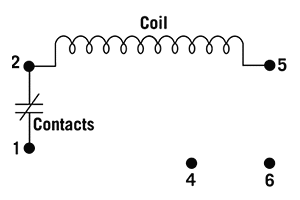


Potential or “voltage” relays are used with single-phase capacitor-start/capacitor-run motors, which need relatively high starting torque. Their main function is to assist in starting the motor.
Knowing the sequence of operation for this type of starting relay can help you diagnose, confirm, or rule out certain service problems.
Potential starting relays consist of a high resistance coil and a set of normally closed contacts. The coil is wired between terminals 2 and 5, with the contacts between terminals 1 and 2.
Terminals 4 and 6 are used for capacitors and/or condenser fan connections and have no electrical significance to the starting relay itself, as shown in Figure 1. In fact, terminals 4 and 6 are sometimes referred to as “dummy” terminals and are simply used for wire connections.
Figure 2 shows how a potential relay is wired to a capacitor-start/capacitor-run compressor motor. Notice that the relay coil is wired in parallel with the start winding and the start capacitor.

When power is applied through the cycling control, both the run and start windings are energized (Figure 2).
The run and start capacitors provide the phase shift for starting torque because their capacitances add up when wired in parallel. In fact, both capacitors are wired in series with the start winding and in parallel with the run winding.
The run capacitor limits the current that will pass through the start winding when the motor is running, because they are wired in series. The run capacitor also provides running torque when the motor is up and running.
The operation of the potential relay is based on the increase in back-electro-motive force (back-EMF) or a bucking voltage that is generated across the start winding as the motor increases in speed. The large metal mass of the motor’s rotor turning at high speeds with motor windings in close proximity has a voltage-generating effect.

The generated back-EMF opposes line voltage and can be measured across the start winding or across the coil of the potential relay at terminals 2 and 5. The back-EMF is usually a higher voltage than the line voltage and can be in the 400-V area.
All motors have different magnitudes of back-EMF, thus requiring different potential relay designs.
The back-EMF voltage generated across the start winding causes a small current to flow in the start winding and potential relay coil, because they are in the same circuit. When the back-EMF has built up to a high enough value (referred to as pick-up voltage), the contacts between terminals 1 and 2 will be picked up (“opened”). This will take the start capacitor out of the circuit.
Pick-up voltage usually occurs when the motor has reached about three-fourths of its speed. The start winding is still in the back-EMF circuit, keeping the relay’s coil energized while the motor is running at full speed.
The contacts open because of the electromagnetic force (magnetism) generated in an iron core around which the relay’s coil is wrapped (Figure 3).
When the cycling control opens, line voltage is taken away from the motor. The motor’s rotor decreases in speed. Thus, the back-EMF generated across the start winding decreases in magnitude. The relay’s coil now sees a lower back-EMF and no longer can generate enough magnetism in its iron core to keep contacts 1 and 2 open.
The contacts therefore return to their normally closed position by spring power as the motor coasts to a stop.
With the start capacitor out of the circuit, the motor becomes a permanent split capacitance (PSC) motor in the running mode only.